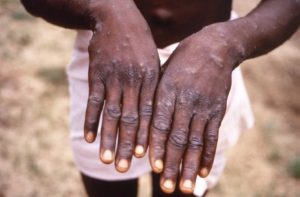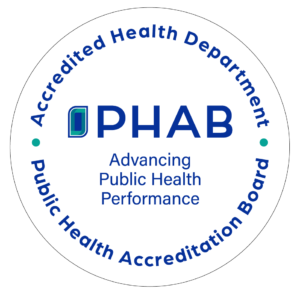What is Monkeypox?

It is a rare but serious illness that is caused by infection with monkeypox virus.
Monkeypox does not occur naturally in the United States, but cases have happened that were associated with international travel or importing animals from areas where the disease is more common.
Scientists at the Centers for Disease Control and Prevention (CDC) are tracking multiple cases of monkeypox that have been reported in several countries that don’t normally report monkeypox, including the United States. As of July 22, 2022, there have been 25,341 confirmed cases of monkeypox in the U.S.
How it Spreads
Monkeypox spreads in different ways. The virus can spread from person-to-person through:
- direct contact with the infectious rash, scabs, or body fluids
- respiratory secretions during prolonged, face-to-face contact, or during intimate physical contact, such as kissing, cuddling, or sex
- touching items (such as clothing or linens) that previously touched the infectious rash or body fluids
- pregnant people can spread the virus to their fetus through the placenta
Monkeypox can spread from the time symptoms start until the rash has fully healed and a fresh layer of skin has formed. The illness typically lasts 2-4 weeks. People who do not have monkeypox symptoms cannot spread the virus to others.
Signs and Symptoms
- Fever
- Headache
- Muscle aches and backache
- Swollen lymph nodes
- Chills
- Exhaustion
- A rash that can look like pimples or blisters that appears on the face, inside the mouth, and on other parts of the body, like the hands, feet, chest, genitals, or anus.
The rash goes through different stages before healing completely. The illness typically lasts 2-4 weeks. Sometimes, people get a rash first, followed by other symptoms. Others only experience a rash.
If you have symptoms of monkeypox, you should talk to your healthcare provider or call your local health department, even if you don’t think you had contact with someone who has monkeypox.
Provider Information for Testing and Treatment
There are no treatments specifically for monkeypox virus infections. However, monkeypox and smallpox viruses are genetically similar, which means that antiviral drugs and vaccines developed to protect against smallpox may be used to prevent and treat monkeypox virus infections.
Antivirals, such as tecovirimat (TPOXX), may be recommended for people who are more likely to get severely ill, like patients with weakened immune systems.
Vaccine Information
The state currently has limited quantities of the Jynneos vaccine. The state is working closely with local health departments and other partners to make doses available in a manner that focuses on locations that have higher case counts and larger higher-risk populations. Based on CDC guidelines and the limited federal vaccine supply, state and local health officials are prioritizing vaccinations courses for PEP in:
- Public Health Identified Close Contacts: Known close contacts who are identified by public health via case investigation, contact tracing, and risk exposure assessments.
- Occupational Exposure: Healthcare workers who may have been exposed to a known case and Laboratory Response Network (LRN) or other laboratory staff working directly with monkeypox testing.
State and local health officials are also following CDC guidelines to make vaccines available, as supplies allow and initially in more greatly impacted areas, to:
- Self-Identified Partners of Cases: Individuals who are aware that one of their sexual partners from the past two weeks has been diagnosed with monkeypox.
- Affected Community Members: Individuals in high-risk populations who report recent group sex or sex with multiple partners or sex or employment at a venue or in association with an event, venue, or defined geographic area where monkeypox transmission has been reported.
Please call our Woodbridge office at 410-612-1779 for monkeypox information and/or vaccine appointments.
For more information on monkeypox from the CDC, click here.
For more information on monkeypox from the Maryland Department of Health (MDH), click here.
Please refer to the CDC website for national case counts.
Please refer to the MDH website for current Maryland case counts.
_______________________________________________________________________________________________
Please click the link below to view the most recent statement from the Maryland Department of Health (8/5/22)
Monkeypox MDH
________________________________________________________________________________________________
Risk Categories for named close contacts of confirmed Monkeypox cases
| Low-Risk Close Contact | Intermediate Risk Close Contact | High-Risk Close Contact |
| Entered the patient room without wearing eye protection on one or more occasions, regardless of duration of exposure | Being within 6 feet for 3 hours or more of an unmasked patient without wearing, at a minimum, a surgical mask | Unprotected contact between a person’s skin or mucous membranes and the skin, lesions, or bodily fluids from a patient (e.g., any sexual contact, inadvertent splashes of patient saliva to the eyes or oral cavity of a person, ungloved contact with patient), or contaminated materials (e.g., linens, clothing) |
| During all entries in the patient care area or room (except for during any procedures listed above in the high-risk category), wore gown, gloves, eye protection, and at minimum, a surgical mask | Activities resulting in contact between sleeves and other parts of an individual’s clothing and the patient’s skin lesions or bodily fluids, or their soiled linens or dressings (e.g., turning, bathing, or assisting with transfer) while wearing gloves but not wearing a gown | Being inside the patient’s room or within 6 feet of a patient during any procedures that may create aerosols from oral secretions, skin lesions, or resuspension of dried exudates (e.g., shaking of soiled linens), without wearing an N95 or equivalent respirator (or higher) and eye protection |
| Being within 6 feet of an unmasked patient for less than 3 hours without wearing at minimum, a surgical mask |
For example, most administrative/front desk staff will likely have low risk exposures. This is in part dependent on location of a patient’s rash and type of interaction with staff members. Most waiting room interactions will be low risk, especially if masking is still required in waiting rooms.


